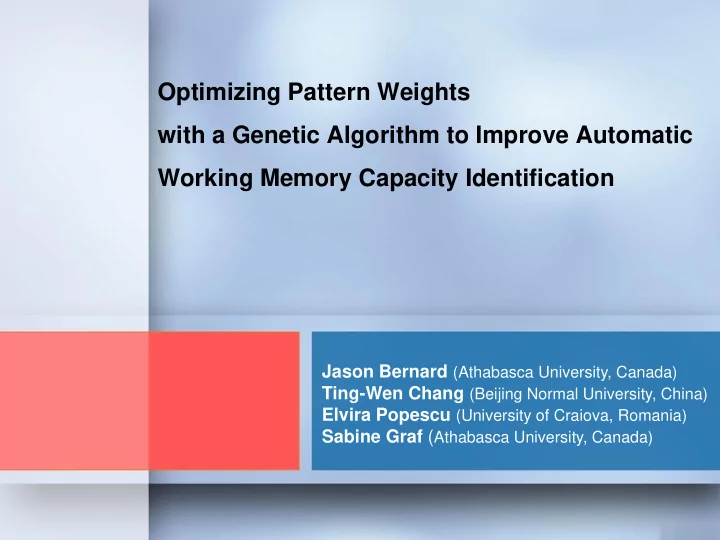

Optimizing Pattern Weights with a Genetic Algorithm to Improve Automatic Working Memory Capacity Identification Jason Bernard (Athabasca University, Canada) Ting-Wen Chang (Beijing Normal University, China) Elvira Popescu (University of Craiova, Romania) Sabine Graf ( Athabasca University, Canada)
Outline Introduction Working Memory Capacity Identifying WMC WMC IDentifier based on Genetic Algorithm (WMCID-GA) Framework Genetic algorithm Evaluation Settings Performance metrics Optimal parameter values Results Conclusion
INTRODUCTION
Working Memory Capacity (WMC) Cognitive trait that influences the learning process: learning speed memorization of learned concepts effectiveness of skill acquisition Related to: students’ reading comprehension skill at mathematics general intelligence Limited to 7 +/- 2 items which may be stored at a time Overload can reduce learning performance, reduce transfer of learning or increase the amount of time needed to learn Awareness Individualized cognitive load Adaptive recommendation mechanism for learning activities Students could better self-regulate their learning Teachers could monitor students’ WM load and use appropriate strategies to reduce overload when necessary
Identifying WMC Traditionally, WMC is measured by asking students to take a specific multitasking test OSPAN (operation span task) (Turner & Engle, 1989) WebOSPAN (Lin, 2007) AOSPAN (Unsworth et al., 2005) Disadvantages Require additional time and effort Influenced by the perceived importance of the test by the students, stress or fatigue Alternative: automatically infer WMC from students’ behavior in learning systems Relevant studies - relationship between WMC and other student characteristics WMC & field-dependent / field independent cognitive style (Graf et al., 2008) FD/FI style & behavior in learning systems (Ford & Chen, 2000), (Chen, 2010) Felder-Silverman learning style model (FSLSM) and WMC (Graf et al., 2009) DeWMC (Detecting Working Memory Capacity) (Chang et al., 2013) Calculates WMC from six patterns (five behavior patterns and students’ learning styles) Assumes that each pattern contributes equally to the calculation of WMC
WMCID-GA
WMCID-GA WMC IDentifier based on Genetic Algorithm An approach for automatically identifying WMC from student behavior Extends DeWMC by using optimized pattern weights, identified through a genetic algorithm 5 behavior patterns + 1 pattern related to learning styles (FSLSM) Linear Navigation Constant Reverse Navigation Performing Simultaneous Tasks Recalling Learned Material Revisiting Passed Learning Objects
WMCID-GA - Steps Extract student data from the learning system database and compute the respective patterns For each pattern, a high or low value is associated to a high or low WMC, based on existing studies from literature For each learning session of a student, a WMC session value is calculated (weighted average of all pattern values) The overall WMC value is calculated by building a weighted average over all WMC session values (considering the amount of available behavior data per learning session as a weight)
Genetic Algorithm Use concepts from evolutionary biology to solve optimization problems Genome 6 genes (one for each pattern) Range of values (i.e. weight of the respective pattern): 0.01 to 1.0 in increments of 0.01 Fitness of a genome average error between the actual and calculated WMC Initialize the population ( P ) with random values for each genome Select P/2 genome pairs - roulette wheel technique Uniform crossover - each gene has a chance of being swapped equal to the crossover weight ( C ) Uniform mutation - each gene has a chance of being mutated equal to the mutation weight ( M ) The new genomes are merged into the population and the genomes with the lowest fitness are culled until the population is size P again Termination condition : GA stops only after Gbest generations passed without finding a new best solution (min.10,000 generations)
EVALUATION
Evaluation Settings Data 75 undergraduate students 5 behavior patterns extracted from Moodle data Felder- Silverman learning styles (identified by the Index of Learning Styles) WMC (identified by WebOSPAN) Students with > 15 errors in WebOSPAN task and students spending < 5 minutes on the learning style questionnaire were removed 63 students Steps 1. Find the optimal values for the parameters of the GA 2. Test overfitting reduction strategies and find optimal parameters for those strategies 3. Run WMCID-GA and get final results (10 fold cross validation was used for each part of the evaluation)
Performance Metrics ACC (accuracy) - measures the difference between the student’s actual WMC and the WMC identified by WMCID-GA LACC - lowest ACC value in the assessment set, measuring the worst case scenario for an individual student %Match - measures the percentage of students who were identified with reasonable accuracy
Optimal Parameter & Overfitting Reduction Settings
Results
CONCLUSION
Findings and Future Work Evaluation shows that WMCID-GA is outperforming DeWMC in all investigated metrics and therefore, can provide more accurate WMC results for more students Results indicate that different patterns have different impact on the WMC identification Future work Investigate the use of other optimization algorithms to see if they can find better solutions Explore hybrid algorithms, which can be useful at overcoming the weaknesses of mono artificial intelligence algorithms
THANK YOU! The authors acknowledge the support of this research by Alberta Innovates Technology Futures, Alberta Innovation and Advanced Education, Athabasca University and NSERC. This work was also supported by a grant of the Romanian National Authority for Scientific Research and Innovation, CNCS - UEFISCDI, project number PN-II-RU-TE-2014-4-2604. Contact: c.j.bernard@ieee.org sabineg@athabascau.ca popescu_elvira@software.ucv.ro
Recommend
More recommend